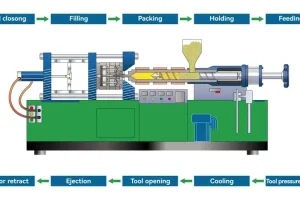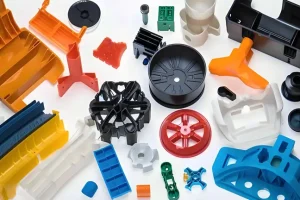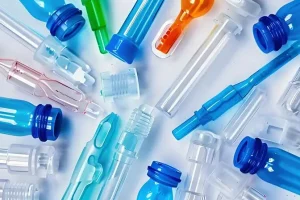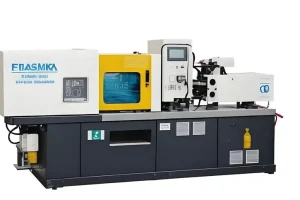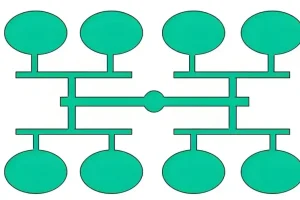Introduction: The back pressure of the injection molding machine is also known as plasticizing pressure. It is the force used to maintain pressure in injection molding. It mainly occurs when the molten material keeps entering the barrel. The pressure formed will push the screw to keep going back. The back pressure is the reaction force to the screw going back.

It can slow down the screw’s retreat speed to ensure that the molten material can be evenly injected into the barrel and make it fully full. Proper adjustment and use of back pressure can make the melt temperature control uniform, compact the molten material, and produce better plastic products. So how to adjust the back pressure and what kind of back pressure is appropriate, Zetar Mold will answer them one by one.
What is the Definition of Back Pressure?
The so-called back pressure is the pressure applied to the rear end of the injection molding machine screw speed. Taking Injection Molding Machine as an example, the back pressure adjustment is mainly divided into three parts: the first is the injection pressure, which is used to strengthen the flow of the molten material; the second is the compaction pressure, which is used to fill the molten material into the mold cavity; the third is the holding pressure, which is used to remove the gas in the molten material.

How is the Back Pressure Formed?
When plastic is melted and softened, it keeps moving forward in the barrel (in the metering section) and gradually builds up pressure, which pushes the screw backward. To prevent the screw from retreating too fast and to make sure the molten plastic is evenly compressed, you need to give the screw some backward pressure. This backward pressure that stops the screw from retreating is called back pressure.

Back pressure, also known as plasticizing pressure, is controlled by adjusting the return oil overflow valve of the injection cylinder. The back pressure valve is installed at the rear of the injection cylinder of the pre-plasticizing screw injection molding machine to adjust the speed of the injection cylinder oil discharge when the screw rotation backward, so that the cylinder maintains a certain pressure; the screw backward speed (resistance) of the full motor is controlled by the AC servo valve.
Where is the Back Pressure Adjustment Position?
The back pressure valve of the injection molding machine is usually located next to the melt valve. The back pressure valve is also installed at the rear of the injection cylinder of the pre-plasticizing screw injection molding machine. The back pressure is controlled by adjusting the return oil throttle valve of the injection cylinder.

How to Determine the Back Pressure Adjustment Value?
When making injection molding machines, the back pressure adjustment value is not fixed, usually 3-15kg/cm. In addition to the nature of the raw materials and the structural quality of the product, the adjustment of back pressure must also be carried out throughout the entire production process.
In production, when the nozzle leaks glue, drools, the melt is overly decomposed, the product changes color, and the return material is too slow, it is necessary to consider reducing the back pressure appropriately.

When a little gas flower, color mixing, shrinkage, and large changes in product size and weight are found on the surface of the product, the back pressure should be appropriately increased. Therefore, the back pressure needs to be properly adjusted according to the production status and its own production experience.
What is the Mechanism of Back Pressure?
Plastic molding back pressure is when you put pressure on the back of the cylinder before you close the nozzle or after you close the mold to keep the plastic from going back and to keep air from getting in. It’s related to things like injection pressure, injection speed, and holding time, and it’s important for making good plastic parts and making them fast. Here’s how it works:

Blow out air: When you’re doing injection molding, sometimes you get bubbles or voids in the plastic. This happens because the plastic is uneven or because there’s something wrong with the nozzle. You can blow out the plastic with back pressure to get rid of the trapped air, reduce the chance of bubbles, and make better parts.
No extrusion residue: When the front end of the syringe is not closed or the rotor starts to move, the molten plastic will stay at the back of the injection cylinder to form a space, and the gas stuck to the inside of the injection molded part will be squeezed out.

Get rid of the plastic that’s left over from the extrusion process and stop the plastic from turning into crystals while you’re making it.
Make the plastic better and make more of it: When you adjust the back pressure just right, it makes the plastic all slippery and smooth, so it flows better. It also keeps the plastic from going back up the screw and slipping around. When you do this, the plastic part you’re making looks better, doesn’t get all bent out of shape, and doesn’t take as long to cool down. This is a big deal when you’re making stuff.

What are the Methods for Adjusting Back Pressure?
The back pressure level affects the pressure injection molding effect and product quality, and its value should be adjusted according to different materials, molds, and processes. According to production requirements and adjustment experience, the back pressure settings value is generally 20% to 50% of the injection pressure. The following is the adjustment method for adjusting the optimal back pressure setting.
Adjust the Injection Pressure
Turn on the injection molding machine, set the injection pressure to a few units, and then inject a product to see how smooth the surface is and if there are any bubbles. You can finally determine the best injection pressure through several tests.

Adjust the Compaction Pressure and Holding Pressure
Just like the injection pressure, adjust the relevant parameters to the preset values, inject a product, check its surface smoothness, bubble situation, plastic part texture and other parameters, and then gradually adjust until the product quality meets the requirements.
Determine the Back Pressure Size According to the Type of Plastic
Different plastics have different back pressure requirements. Generally, plastics with low melting points need low back pressure, while plastics with high melting points need high back pressure. So, the back pressure size should be adjusted according to the specific type of plastic during the injection molding process.

Adjust According to the Size and Shape of the Injection Molded Part
Different sizes and shapes of injection molded parts have different requirements for back pressure. In general, larger injection molded parts require higher back pressure, while smaller injection molded parts require lower back pressure. Therefore, when adjusting the back pressure, pressure settings typically start determined by the specific plastic type.
Adjusting the Mold Temperature
Mold temperature is one of the important factors affecting the size of the back pressure. When adjusting the back pressure, you can first adjust the mold temperature, and then make corresponding modifications based on the adjusted back pressure effect.

Adjusting the Injection Molding Machine Pressure Setting
The pressure setting of the injection molding machine will also affect the size of the back pressure. Generally speaking, a higher pressure setting requires a higher back pressure, and a lower pressure setting requires a lower back pressure. When adjusting the back pressure, you can first adjust the pressure setting of the injection molding machine appropriately, and then make corresponding modifications based on the effect of the adjusted back pressure.

Selecting the Appropriate Back Pressure
Choose the right back pressure according to the mold structure and plastic raw materials. By adjusting the back pressure, the product surface is smooth and the size is stable, avoiding defects such as product cracking and bubbles.
Dynamic Adjustment
The size of the back pressure during the injection molding process should be adjusted dynamically, and the size of the back pressure should be adjusted according to the actual situation. When defects occur during the injection molding process, the size of the back pressure needs to be adjusted in time.

What are the Precautions for Adjusting the Back Pressure?
Adjusting the Injection Pressure
Normally, the injection pressure is set at 1.5 to 2 times the back pressure, depending on the specific product requirements. If it’s too high, the melt will be squeezed out at the front end of the screw, causing leakage and bubbles; if it’s too low, the melt will be loose and prone to bubbles.

Adjust the Compaction Pressure
This pressure needs to be determined according to the thickness, length, width, wall thickness and other parameters of the injection molded product. Usually, this value can be set according to the parameters in the injection molding machine manual.
Adjust the Holding Pressure
The reason we hold pressure is to get as much gas out of the melt as possible so we don’t have bubbles. Normally, this value is set at 50% of the pack pressure.

What are the Side Effects of Improper Back Pressure Adjustment?
When the back pressure is too low, the screw retreats too fast. The density of the melt flowing into the front end of the barrel is small (loose), and more air is trapped. This will lead to poor plasticization quality, unstable injection volume, large changes in product weight and product size, shrinkage, gas flowers, cold material lines, uneven gloss, and other undesirable phenomena on the surface of the product.
Bubbles are easy to appear inside the product, and the periphery and bone position of the product are easy to move, and the glue is not full.

When the back pressure is too high, the melt pressure at the front end of the barrel is too high, the material temperature is high, the viscosity decreases, the melt backflow in the screw groove and the leakage flow between the barrel and the screw increase, which will reduce the plasticization efficiency (the amount of material plasticized per unit time).
For plastics with poor thermal stability (such as PVC, POM, etc.) or colorants, the melt temperature increases and the heating time in the barrel increases, causing thermal decomposition, or the colorant discoloration increases, and the surface color and gloss of the product deteriorate. If the back pressure is too high, the injection screw retreats slowly, and the pre-plasticization return time is long, the cycle time will be increased, resulting in a decrease in production efficiency.

The back pressure is high, the melt pressure is high, and the nozzle is prone to melt drooling after injection; the next time the glue is injected, the cold material in the nozzle flow channel will block the nozzle or cold material spots will appear in the product.
During the pre-plasticization process, the nozzle often leaks glue due to excessive back pressure, which wastes raw materials and causes the heating ring near the nozzle to burn out. The mechanical wear of the pre-plasticization mechanism and the screw barrel increases.

The right back pressure of the injection molding machine is a booster for improving product quality. Mastering the adjustment of back pressure is helpful to improve production efficiency and quality.
What are the Benefits of Properly Adjusting Back Pressure?
By adjusting the back pressure properly, the air in the mold channel can be removed. During the injection molding process, if the air in the mold cavity is not completely exhausted, bubbles will be generated when the plastic is melted and filled, which will affect the quality of the product and increase the defect rate. By increasing the back pressure properly, the air in the mold cavity can be removed, and the quality of injection molding can be ensured.

Adjusting the back pressure properly can adjust the melt flow state. The back pressure can change the diffusion speed and flow state of the plastic melt, making the plastic melt smoother and reducing the defects and unevenness caused by the flow of the melt.
Adjusting the back pressure properly can make the molten material in the barrel compact, increase the density, and improve the stability of the shot weight, product weight and size. Adjusting the back pressure properly can “squeeze out” the gas in the molten material, reduce the gas flowers and internal bubbles on the surface of the product, and improve the uniformity of the gloss.

Adjusting the back pressure properly can slow down the screw retreat speed, fully plasticize the molten material in the barrel, increase the mixing uniformity of the color powder, masterbatch and molten material, and avoid color mixing in the product.
Increasing the back pressure properly can improve the shrinkage of the product surface and the glue flow around the product. Properly adjusting the back pressure can increase the temperature of the molten material, improve the plasticization quality of the molten material, improve the fluidity of the molten material during mold filling, and there will be no cold glue lines on the surface of the product.

Conclusion
Basically, adjusting the back pressure of the injection molding machine is a matter of combining it with the specific situation, doing more tests and experiments, and making continuous adjustments to achieve the best injection molding effect and produce high-quality injection molding products.

By adjusting the back pressure of the injection molding machine through the above methods, the quality and efficiency of the injection molding process can be optimized. In addition to the back pressure, there are many key parameters that need to be adjusted in injection molding. Processing personnel can make flexible processing adjustments according to different product types and process requirements.


